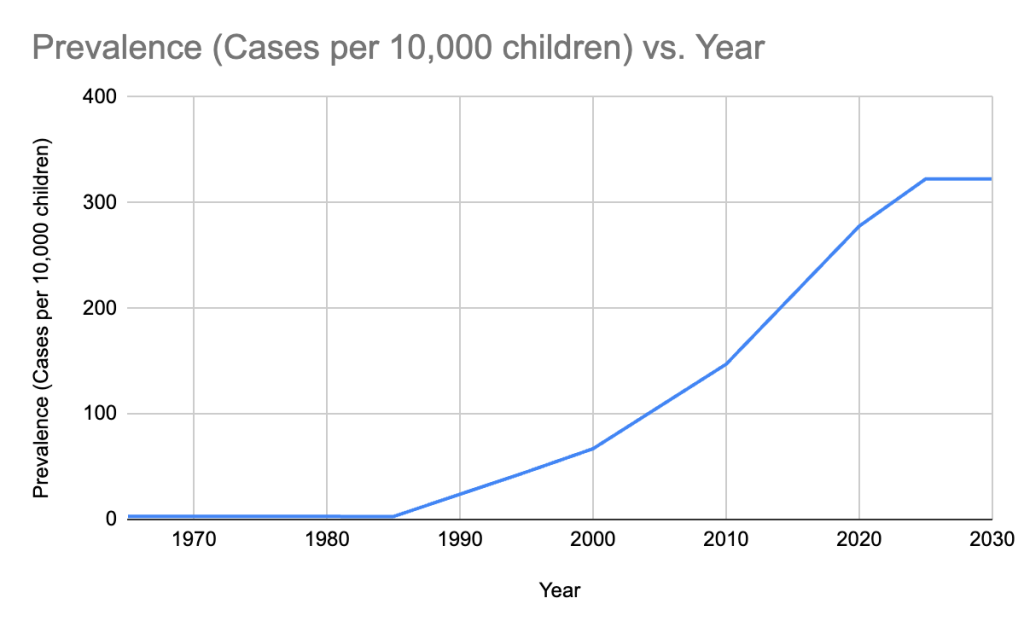Rapid City, SD – Autism spectrum disorder (ASD) has become one of the most discussed and studied conditions of the modern era. Once considered exceedingly rare, autism diagnoses have surged dramatically in recent decades. While increased awareness and improved diagnostic tools explain part of this rise, the consistent upward trend continues to raise questions and concerns about potential environmental and pharmaceutical factors
A Brief History of Autism
The term autism was first introduced in 1911 by Swiss psychiatrist Eugen Bleuler, who used it to describe a subset of schizophrenia. It wasn’t until 1943 that autism was recognized as a distinct condition, thanks to Austrian-American psychiatrist Leo Kanner.
Kanner’s landmark paper described 11 children with “early infantile autism,” highlighting core features such as:
- Social withdrawal
- Repetitive behaviors
- Communication difficulties
- His work laid the foundation for what is now recognized as autism spectrum disorder (ASD).
- Tylenol and Its Introduction
While the definition of autism was evolving, another medical milestone was occurring. Tylenol (acetaminophen) became available over the counter in the U.S. in 1960, after previously being a prescription-only medication. The FDA approved it as safe and effective, ushering in its widespread use as one of the first non-aspirin pain relievers available without a prescription.
The timing of Tylenol’s rise to popularity is notable, as it parallels the decades during which autism diagnoses began to increase. While no study to date can definitively claim that acetaminophen causes ASD or ADHD, its widespread use and the correlation observed in multiple studies have prompted scientific concern.
Autism Rates Over Time
Tracking the prevalence of autism paints a clear picture of concern:

1960s – Just 2–4 cases per 10,000 children (~0.2–0.4 per 1,000).
1970s – Estimates at 1–5 per 10,000, with some reports as low as 1 in 10,000 (~0.01%).
1980s – Rates at 1–4.5 per 10,000 (~0.1–0.45 per 1,000).
1990s – A rise to 2–7 per 1,000, with some studies showing 7.5 per 1,000.
2000 – CDC reported 6.7 per 1,000 (~1 in 150 children).
2010 – Prevalence doubled to 1 in 68 children (14.7 per 1,000).
2020 – Rates reached 1 in 36 children (~2.8%). For the first time, prevalence was higher among Black, Hispanic, and Asian/Pacific Islander children than White children.
2025 – CDC data pointed to 1 in 31 children, continuing the alarming upward trajectory.
2030 (projected) – Current trends suggest prevalence could remain at or exceed 1 in 31 children if the rise continues.
Research on Acetaminophen and Autism
Mount Sinai Press Release – September 10, 2025
A systematic review from the Icahn School of Medicine at Mount Sinai, published on September 10, 2025, strengthens evidence that prenatal acetaminophen exposure may increase the risk of ASD and ADHD.
Key findings:
- Review of 46 studies with over 100,000 participants worldwide.
- Highest-quality studies were most likely to show an association.
- Mechanisms: acetaminophen crosses the placenta and may disrupt fetal brain development via oxidative stress, hormone interference, or epigenetic changes.
- More than half of pregnant women worldwide use acetaminophen.
- The study emphasizes correlation, not proven causation, but urges cautious, limited use under medical guidance, updated clinical recommendations, and further study to clarify risks while balancing the dangers of untreated fever or pain.
Harvard T.H. Chan Report – August 20, 2025
- On August 20, 2025, Harvard T.H. Chan School of Public Health reported on a systematic review—published August 14 in BMC Environmental Health—led by Mount Sinai. Findings reinforced concerns about acetaminophen use during pregnancy:
- Longer or heavier prenatal use (four weeks or more) showed stronger associations with ASD and ADHD.
- Study employed the Navigation Guide methodology to rigorously evaluate evidence.
- Researchers emphasized careful weighing of risks and benefits: acetaminophen should be used only at the lowest effective dose and for the shortest duration, rather than avoided completely.
- Again, the study demonstrates correlation, highlighting potential risks without establishing direct causation.
Birth Injury Center – JAMA Psychiatry Study, 2020
A 2020 study in JAMA Psychiatry reported a significant association between prenatal acetaminophen exposure and increased risks of ASD and ADHD.
- Cohort of 996 mother-infant pairs
- 257 children developed ADHD only
- 66 children developed autism only
- 42 children developed both conditions
The study concluded that in-utero acetaminophen exposure was statistically linked to higher rates of ASD and ADHD, though this represents correlation rather than proven causation. The FDA had previously raised concerns in 2015 but maintained guidance due to conflicting evidence.
Johns Hopkins Bloomberg School of Public Health Study – November 5, 2019
A 2019 study from Johns Hopkins analyzed umbilical cord blood samples from 996 births and found that children with the highest prenatal levels of acetaminophen and its metabolites were about three times more likely to be diagnosed with ASD or ADHD compared to those with the lowest exposure.
This study strengthens concern about the potential neurodevelopmental risks associated with acetaminophen use during pregnancy, while still reflecting observed correlation rather than causation.
Autism Open Access Study – March 28, 2016
- The 2016 study “Acetaminophen Use for Fever in Children Associated with Autism Spectrum Disorder” explored whether acetaminophen use for fevers in children is linked to ASD.
- Case-control study found children with ASD were more likely to have received acetaminophen for fever (p = 0.013).
- Ibuprofen use was not significantly associated with ASD.
- Children with ASD showed greater increases in sociability during fevers than non-ASD children (p = 0.037).
- The authors proposed a mechanism involving the endocannabinoid system, theorizing that frequent acetaminophen use may reduce endocannabinoid “tone,” potentially affecting neural development. Again, this represents a correlational finding, not proof of causation.
What Does This Mean?
The rise in autism diagnoses is undeniable. Mount Sinai, Harvard, JAMA Psychiatry, Johns Hopkins, and Autism Open Access studies all point to growing concern that environmental exposures—including commonly used medications like acetaminophen—may play a role.
Although scientists are currently unable to claim that acetaminophen definitively causes ASD or ADHD, the data and findings are significant enough to warrant concern, given the consistent correlations observed across multiple high-quality studies. While improved diagnostics explain part of the increase, the scale and speed of the rise demand further investigation.
Key takeaways:
- Cautious use of acetaminophen during pregnancy and childhood fevers.
- Continued large-scale studies to explore environmental and pharmaceutical links.
- Greater investment in autism support and intervention services.
- Understanding why autism has become so prevalent remains one of the most pressing public health challenges of our time.
About the Author
Dr. Trey A. Sauvage, DDS is a general dentist based in Rapid City, SD. Dr. Sauvage obtained a B.S. from South Dakota School of Mines in 2015, a M.S. in Biomedical Engineering from South Dakota Mines in 2017, and a Doctorate of Dental Surgery from the University of Minnesota in 2021.
Works Cited
Centers for Disease Control and Prevention (CDC). (2025). Prevalence of autism spectrum disorder among 8-year-old children—Autism and Developmental Disabilities Monitoring Network, United States, 2025. Retrieved from https://www.cdc.gov/autism
Bleuler, E. (1911). Dementia praecox or the group of schizophrenias. New York: International Universities Press.
Kanner, L. (1943). Autistic disturbances of affective contact. Nervous Child, 2, 217–250.
U.S. Food and Drug Administration (FDA). (2015). Acetaminophen and pregnancy: safety communication. Retrieved from https://www.fda.gov
Icahn School of Medicine at Mount Sinai. (2025, September 10). Systematic review links prenatal acetaminophen exposure with increased risk of neurodevelopmental disorders. Mount Sinai Press Release.
Harvard T.H. Chan School of Public Health. (2025, August 20). Review highlights potential risks of prenatal acetaminophen use. BMC Environmental Health, 25, 102. https://doi.org/10.1186/s12940-025-0102-x
Brandlistuen, R. E., Ystrom, E., Nulman, I., Koren, G., Nordeng, H. (2020). Prenatal paracetamol exposure and child neurodevelopment: prospective birth cohort study. JAMA Psychiatry, 77(1), 12–19. https://doi.org/10.1001/jamapsychiatry.2019.3198
Liew, Z., Ritz, B., Rebordosa, C., Lee, P. C., Olsen, J. (2019). Acetaminophen exposure in pregnancy and risk of autism spectrum and ADHD: cord blood biomarker study. Environmental Health Perspectives, 127(11), 117006. https://doi.org/10.1289/EHP5320
Schultz, S. T., Klonoff-Cohen, H., Wingard, D. L. (2016, March 28). Acetaminophen use for fever in children associated with autism spectrum disorder. Autism Open Access, 6(2), 1000172. https://www.ncbi.nlm.nih.gov/pmc/articles/PMC4846384/
Centers for Disease Control and Prevention (CDC). (2000–2020). Autism and Developmental Disabilities Monitoring (ADDM) Network Reports. Retrieved from https://www.cdc.gov/ncbddd/autism/addm.html
‘Autism Epidemic Runs Rampant,’ New Data Shows 1 in 31 Children Afflicted





